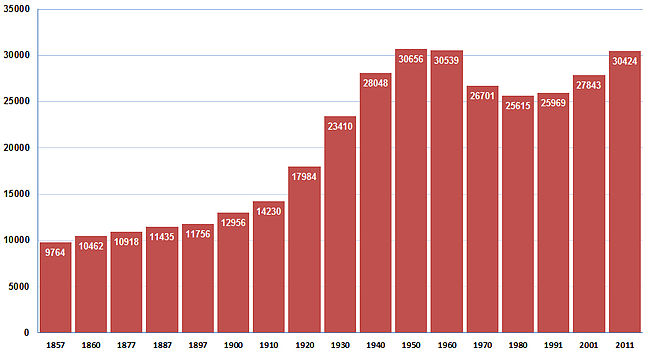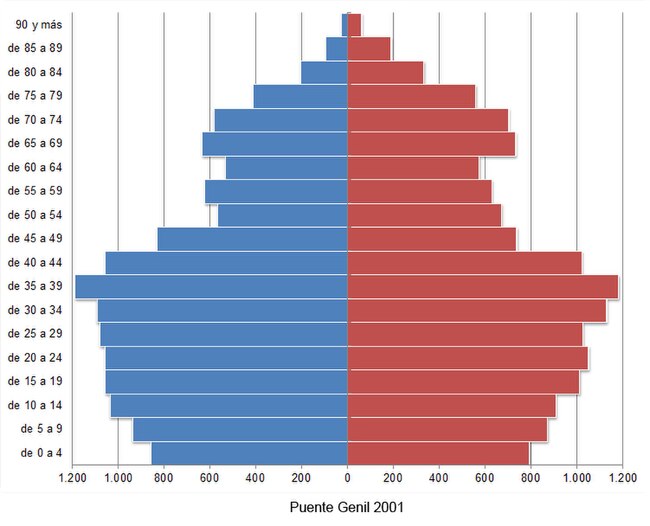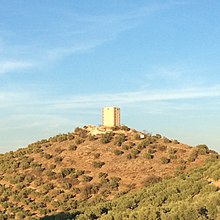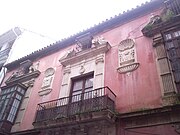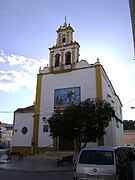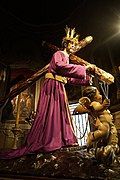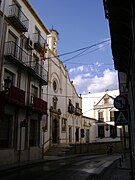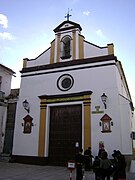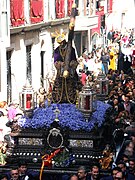Puente Genil
| Puente Genil municipality | ||
|---|---|---|
 Aerial view of Puente Genil
|
||
| coat of arms | Map of Spain | |

|
|
|
| Basic data | ||
| Autonomous Community : | Andalusia | |
| Province : | Cordoba | |
| Comarca : | Campiña Sur | |
| Coordinates | 37 ° 23 ′ N , 4 ° 46 ′ W | |
| Height : | 216 msnm | |
| Area : | 171.05 km² | |
| Residents : | 30,048 (Jan. 1, 2019) | |
| Population density : | 175.67 inhabitants / km² | |
| Founding: | 1242 | |
| Postal code : | 14500 | |
| Municipality number ( INE ): | 14056 | |
| Nearest airport : | Cordoba | |
| administration | ||
| Official language : | Castilian | |
| Mayor : | Esteban Morales Sánchez ( PSOE ) | |
| Address of the municipal administration: | Calle Don Gonzalo nº 2 | |
| Website : | www.puentegenil.es | |
Puente Genil is a Spanish municipality in the southwest of the Andalusian province of Córdoba . The inhabitants call themselves Pontaneses or Pontanesas , in the singular Pontanés or Pontanesa .
Geographical location
Puente Genil is conveniently located in the center of Andalusia . The major cities of the region can be reached quickly by train and car: Córdoba is 69 km away, Málaga 110 km, Seville 120 km and Granada 150 km. The municipal boundary is partly identical to the provincial border with the province of Seville .
climate
Puente Genil has a Mediterranean climate with a continental touch . In winter, daytime temperatures can drop below freezing, while in summer they can exceed 40 ° Celsius.
history
Prehistory and early history
Various archaeological finds from the area prove that the place was already populated in the Mesolithic . Typical stone tools of a hunter-gatherer society made of flint and quartzite , for example hand axes, scraping and cutting tools, were found. In contrast, relatively few finds were discovered from the Neolithic Age. These are mainly processed animal bones and human bones from the Cueva de los Vientos cave in the Sierra del Castillo.
Around 3000 BC, the people of the region began to work metals. The Copper Age and Bronze Age are well documented in the area in deposits such as Fuente del Lobo , Cerro del Ahorcado, and Camorra de Puerto Rubio . Remains of bell ceramics have been found in these sites, as well as materials made of polished or carved stone that were used as knives, axes, dechs or sickles. There were also metalworking tools, such as crucibles and molds, as well as a variety of tools and weapons, such as knives, arrowheads and daggers.
Towards the end of the Bronze Age, the region experienced strong influences from other areas of the Iberian Peninsula and the eastern Mediterranean. The middle Genil valley belongs to the Tartessian sphere of influence and to its successor, the Turdetan culture. The villages of Castellares , Las Gaseosas and La Villeta de las Mestas date from this period . In the local history museum you can find finds from these villages, for example polished ceramics and ceramic fragments with incised decorations, metal objects such as fibulae or arrowheads and Corinthian ceramics from the 4th century BC. Further pieces of evidence for the Iberian presence are zoomorphic limestone sculptures from grave goods.
Foundation and association
Originally the bridge over the Genil and the place named after it was called Pontón de Don Gonzalo or Puente de Don Gonzalo , after the local nobleman at the time. The place was at the time of King Ferdinand III. founded, was on the right side of the river and belonged to the province of Cordoba. The small village of Miragenil was on the opposite bank and was then part of the province of Seville . By royal decree of María Cristina de Bourbon in December 1834, the two parishes were united, and the city was given its name, Puente Genil, which is still used today.
administration
| period | Surname | Political party |
|---|---|---|
| 1979-1983 | Manuel García Cejas (1979-80), Miguel Salas Ariza (1980-83) |
|
| 1983-1987 | Manuel Baena Jiménez |
|
| 1987-1991 | Miguel Vallejo Berral (1987–90), Joaquín Cortés García (1990–91) |
|
| 1991-1995 | Joaquín Cortés García |
|
| 1995-1999 | Miguel Vallejo Berral | Unidad Genilense Independiente |
| 1999-2003 | Manuel Baena Cobos |
|
| 2003-2007 | Manuel Baena Cobos |
|
| 2007-2011 | Manuel Baena Cobos |
|
| 2011-2015 | Esteban Morales Sánchez |
|
| 2015-2019 | Esteban Morales Sánchez |
|
population
Development in the recent past:

economy
Industry
Puente Genil is one of the most industrialized municipalities in the province of Cordoba. The dominant factor is the agro-food industry, for example the production of olive oil, industrial baked goods, and canned fruit and vegetables. Products for construction are also of great importance.
In recent years, the city has seen strong growth in the electric lighting sector. Other branches of industry such as furniture and wood construction, ceramics, electromechanics, the manufacture of handling and lifting equipment, chemical products and soaps, textile companies, sales and logistics companies are also represented. Craft businesses for bronze casting, wood and inlay work, pottery and embroidery were also able to survive.
The Bodegas Delgado winery is well known . It was founded in 1874. Their wines and sherryis are stored in American oak barrels and traded under the Montilla-Moriles Designation of Origin .
Agriculture
The main agricultural products are olives, wine and quinces . The total area of olive groves in this area is 9,927 hectares, which is 64.73% of the total cultivated area. The major part of the production is intended for the extraction of oil. The area for viticulture is 366.08 hectares, which is about 2.3% of the area cultivated in Puente Genil. The warm and dry climate and the typology of the soils favor viticulture.
traffic
old trainstation
The old Estación de Puente Genil station in the center only serves as a freight station.
Passenger station Puente Genil - Herrera
The modern train station Estación de alta velocidad is 4 km outside the city, between Puente Genil and Herrera . Several times a day there are connections to Seville, Málaga, Córdoba, Madrid, Saragossa and Barcelona .
The external characteristic of the modern train station is the projecting roof. Below that, the passenger building was built in the form of an elevated passage with a view of the tracks. Services such as a travel center, cafeteria, trade and a 410 m² foyer are housed in this passage with a floor area of 1,550 m². The difference in height between the platforms and the passage is about six and a half meters. Escalators and panoramic elevators lead down to the four tracks. The station has four tracks, two through the central building and two through eye-catching tent structures on the sides. The parking lot with a capacity of 250 spaces is covered by canopies, similar to that of the platforms.
Buildings and Monuments
Historic buildings
Roman villa of Fuente Álamo
The villa was built in the 3rd century AD and existed until the 6th century. Their buildings are spread out on both sides of a stream. In the 4th and 5th centuries it reached its greatest splendor and luxury. One of the rooms may have served as a place of worship for the oriental god Mithras before Christianization . If so, it is the best preserved Mithras sanctuary in the Iberian Peninsula. The latest excavations also revealed that the 3rd century villa was founded on the site of a former public bath. A number of basins date from the first century, some with a curved plan.
A large part of the site is taken up by a system of storage rooms for supplies on the north side. Grain was stored there, but probably no wine or oil. The granaries were built in an elevated position and provided with ventilation ducts through which warm air flowed, which protected the wheat from rotting.
The southern part of the villa is on the other side of the stream and is exceptionally well preserved. It is connected to the northern part by a 38-meter-long gallery that led across the stream. In this southern part there is a square auditorium with apses on all four sides. The floor is made up of a mosaic depicting the Nile as a river god in the middle and a battle between pygmies and cranes in the vignettes . Next to it are the baths, whose hypocaust has been preserved in a fairly good condition.
The plush part of the villa is known for its abundance of mosaics. These formed the most important archaeological ground for the excavations. As an expression of the social position and wealth of the owner, they were considered an expensive luxury object to which not everyone had access. The mosaics from Fuente Álamo are considered unique in the entire Roman Empire.
During the time of the Caliphate of Cordoba , some of the buildings in the north were used for an oil mill. Other parts were occupied by a village community, which partially inhabited the existing structures, but also looted and destroyed some.
Castillo Anzur
This castle is located at an altitude of 467 meters on the northern end of a ridge. From there it dominates much of the landscape of Cordoba and Seville, and particularly the Puente de Don Gonzalo , the bridge that led to the founding of Puente Genil. The Navaluenga stream flows at their feet. From the east it must have been impregnable because of the Peñarrubia Gorge.
The origins are probably related to the Islamic conquest. However, the name is probably not Arabic, but appears to be a Roman place name, Aranzuel , derived from Arienzo , which refers to an ancient Iberian coin. After the reconquest of the area by Ferdinand III in 1241. Anzur Castle was an important point of defense on the Muslim border. The building from the Gothic period consisted of an adobe building north of the fortress, a fortification with towers and a large central tower. The wall enclosure and the central tower were built in the first half of the 14th century.
Civil architecture
Puente Genil has many examples of remarkable civil architecture: from the bridge that connects the two historic quarters of the city, to palace buildings from the eighteenth and nineteenth centuries, to the industrial architecture of the late nineteenth and early twentieth centuries, which testify to the economic development of this period.
Bridge over the Genil
The 11th or 12th century bridge on which the settlement was founded was probably a simple wooden pontoon . It was not until 1561 that the city council commissioned the architect Hernán Ruiz II from Córdoba to build a stone viaduct, which was completed in 1583. The large round column in the middle has been preserved from him.
In 1684 the arch on the Miragenil side collapsed as a result of a flood. In 1703 two new arches were built on this side under the builder Matías Solano, and in 1728 the other side was renewed by the builder Juan Antonio Camacho. Today the Solano arches are preserved, as the broad brick arch on the other side was built in 1874 by the French engineer Leopoldo Lemoniez.
Mayordomía of the Dukes of Medinaceli
The Mayordomía of the Dukes of Medinaceli is a generous palazzo from the 18th century. The baroque main facade on Calle Don Gonzalo is adorned with coats of arms and artistically designed balconies. Red jasper columns decorate the elegant courtyard. Inside, the main staircase and the golden hall with its precious furniture are remarkable.
Balcony on the first floor
Teatro Circo
The eclectic- style building by Rodrigo García was inaugurated in 1902. It is located in the historic La Isla district . After the floods of 1963, it remained closed for three decades until it reopened in February 1995. The original, valuable stage curtains and the precious chandelier were unfortunately lost and were replaced by less noble material.
In addition to the open-air theater in the Parque de los pinos , the Teatro Circo is the largest stage in Puente Genil. It offers 288 audience seats.
Liceo mercantil
The Liceo mercantil , the trading club, was built in 1897 by Antonio López Muñoz based on a design by Rodrigo García. The Venetian Palazzo Vendramín-Calerqi served as a model . In order to come close to the effect of this model, white lime plaster was used for the facade, which is otherwise not common in Puente Genil. The building has remained practically unchanged since its construction and is in perfect structural condition. The ornate balconies and windows on the ground floor offer views of the riverside and orchards. The cast iron columns and the iron staircase are remarkable.
The city administration is currently using the rooms on the second floor.
Cortijo Las Monjas
The Cortijo Las Monjas is a manor house with a living space of 573 m². It was built in 1869 and served as a religious house for a community of Paulus von Thebes who had been expelled from Lepoglava in Croatia . It is believed that this religious community brought the art of bobbin lace to Andalusia. The building is remarkable for its exposed location on a hill and its appearance in the typical Andalusian style.
Sacred buildings
description
In Puente Genil there is a large number of historic church buildings, most of which are still used for church services. They are often richly furnished with historically and artistically valuable paintings, sculptures, carvings, main and hub altars with artistically designed retables , often decorated with niches, shrines and columns and covered by an attic . The baroque period is particularly well represented , but there are also numerous examples from classicism , the 19th century to eclecticism and the present. Frequent motifs of the pictures and sculptures are the city patrons, St. Mary and Jesus of Nazareth , as well as Francis , apostles and martyrs.
- The Parish Church of Nuestra Señora de la Purificación is the oldest church in the city and the main parish church. However, the basic medieval structure is still recognizable. Its current classical appearance is due to large works in the 19th century. One of the church treasures is a tabernacle from the 18th century richly decorated with sculptures and goldsmith's art .
- The parish church of Santiago el Mayor was consecrated in 1705 . Nothing has survived from the previous church from 1630 and the even older chapel of Santa Lucía de los Tejares from 1616.
- The Sanctuario Nuestro Padre Jesús Nazareno was originally a simple single-nave chapel outside the city. A comprehensive redesign took place in the 19th century. The interior is characterized by a particularly rich and valuable variety of works of art, including an ornate shrine dedicated to the church patron Jesus of Nazareth. It is visited almost daily by numerous believers. In 2014, the Bishop of Cordoba awarded the Church the title of Diocesan Shrine .
- The neo-Gothic parish church of Nuestra Señora del Carmen was originally the chapel of the earlier industrial flour mill of the same name, which existed until 1917.
- The Iglesia de la Concepción , dedicated to the patroness of the city, was built in the second half of the 18th century. The main facade from 1799 shows the beginning of the neoclassical aesthetic.
- The Church of Nuestra Señora de la Victoria was built in the 17th century. It was originally part of a Paulaner convent . Its adjacent building now serves as the city's historical museum. Inside the church, the numerous baroque altarpieces are remarkable, the largest of which is badly weathered.
- The Iglesia de los Ángeles y San Francisco , completed in 1705 , originally belonged to a convent of the barefoot Franciscans , which was abandoned in 1664. In this church the Semana Santa is proclaimed every Palm Sunday . Many instrumental and choral concerts are also held there.
- The modern and functional designed church Realeza de María was consecrated in 1955. It belongs to the adjacent college of the Mariengesellschaft founded in 1904.
- Nuestra Señora de los Desamparados is a modern new building that was built in 2001 instead of a neo-Gothic predecessor church from 1925 that was demolished the previous year. Every year in May there is a procession in honor of the church patron starting from the church.
- The Ermita del Dulce Nombre de Jesús was built from 1583 to 1589. It was the church of the fraternity of the same name. In 1786 it was in ruins, in 1790 it was rebuilt. Noteworthy are the coffered ceiling in the choir and a shrine with a carved wooden representation of Mary.
- The small baroque chapel Señor del Río is no longer used for church services.
Picture gallery
Industrial architecture
- La Aurora was built in 1897 to house the power station. The facade is characterized by decorative exposed bricks, whichare supposed to be reminiscent ofthe Mudejar style .
- La Alianza was built in 1887 by the French engineer Leopoldo Lemoniez as a flour mill and hydroelectric power station. The four-story building has large ornate windows and a facade in which white stones from the Sierra Grossa are used as decorative elements.
- The Edificio del Carmen is a building of rural modernism of 1904, which today houses a hotel.
- The iron bridge from 1876, also a construction by Leopoldo Lemoniez, is located above the hamlet of El Palomar.
Culture
Events and festivals
«¡Puente Genil hermoso, el más culto y religioso de la hermosa Andalucía, donde hay ricas procesiones, donde hay puras tradiciones ... donde el vino es exquisito!»
"Wonderful Puente Genil, noblest and most religious of the wonderful cities of Andalusia, where splendid processions and pure tradition take place ... where the wine is exquisite!"
Holy Week
The Semana Santa , also called Mananta in Puente Genil , is a festive highlight of the year. The population triples on Maundy Thursday and Good Friday . Religious brotherhoods, which mostly arose in the 16th and 17th centuries, are the most important operators of processions and ceremonies. There are 23 of them in Puente Genil. They are supported by the diocese of Cordoba. In addition, free civil religious groups contribute to the celebrations. The members gather in their meeting places , sing saetas with religious content and toast with wine. Some groups dress in special robes in which they represent, for example, biblical figures. A particularly noticeable group is called Imperium Romanum : its members dress up as Roman soldiers and contribute to the music to a large extent.
The celebrations culminate from Maundy Thursday. The brotherhoods hold their processions through the city. At more than 30 stations that have a religious connection to Jesus, Mary or a holy person, penitential prayers are said. Saetas and other religious songs are sung and poems are spoken in the streets. The climax is reached on Holy Saturday at the large gathering in the Plaza Calvario.
A multitude of poets and singers contributed with their creations to the Semana Santa of Puente Genil.
Other festive days
- The Feria Real takes place between August 14th and 19th.
- The Rock and River Blues Festival was launched in 2005.
- The Verano Joven , the summer of youth, offers young people from childhood to 35 years of age a range of sporting activities, including a street soccer tournament, a night hike to the Sierra del Niño and canoeing on the Genil.
- The Cante Grande Fosforito Festival , one of the most important Flamenco festivals in Spain, takes place every August.
Nature parks
- Natural park and reservoir Embalse de Cordobilla
- Laguna Tiscar
Educational institutions
Puente Genil has the following educational institutions:
-
Private schools ( Centros Docentes Privados ):
- CDP Alemán : German-speaking kindergarten, elementary and secondary school.
- CDP Compañía de María : Kindergarten, elementary and secondary school and special education.
-
Colegios de Educación Infantil y Primaria :
- CEIP Agustín Rodríguez
- CEIP Castillo de Anzur
- CEIP Dulce Nombre
- CEIP José María Pemán
- CEIP Enrique Asensi
- CEIP Ramiro de Maeztu
- CEIP Santiago Ramón y Cajal
-
Escuela Infantil and Colegios de Educación Infantil :
- EI La Divina Providencia
- CEI Angel de la Guarda
- CEI Mafalda
- CEI Proyecto Educa
-
Institutos de Educación Secundaria :
- IES Fuente Álamo: Carece de Bachillerato.
- IES Ingeniero Juan de la Cierva
- IES Manuel Reina
- IES Professor Andrés Bojollo
- Centro de Educación Permanente Los Pinos
- Escuela Municipal de Música
Public healthcare system
The modern Alto Guadalquivir regional hospital has an emergency service, operating theaters and departments for dermatology , general and visceral surgery , cardiology , pulmonology , ENT , hematology , anesthesia , gastro-enterology , urology , gynecology and obstetrics , ophthalmology , radiology , clinical analysis and preventive medicine. The new veterinary hospital has multiple animal health services and operating rooms for animal surgery .
Personalities
- Manuel Reina Montilla (1856–1905), poet
- Juan Rejano (1903–1976), poet
- Ricardo Molina (1917–1968), poet
- Fosforito (* 1932), flamenco singer
- Victor Sojo (* 1983), national hockey player
- Edu Aquilar (* 1976), national hockey player
- Álvaro Cejudo (* 1984), football player
- Rodolfo Gil y Fernández (1872–1938), politician, civil governor of Ourense and Tarragona , victim of the Spanish Civil War
- Leonor Lavado (* 1983), actress and cabaret artist
References and comments
- ↑ Cifras oficiales de población resultantes de la revisión del Padrón municipal a 1 de enero . Population statistics from the Instituto Nacional de Estadística (population update).
- ↑ Esteban Morales Sánchez: Moción que presenta el Grupo Municipal Socialista al Ayuntamiento en pleno relativa a rotular una calle con el nombre del que fuera primer alcalde democrático de Puente Genil D. Manuel García Cejas. (PDF) Grupo Municipal Socialista, accessed on June 10, 2019 (Spanish).
- ↑ Listado de alcaldes 1979 de Andalucía. Ministerio de Administraciones Públicas.
- ↑ M. Á. C .: Fallce a los 86 años el ex alcalde Manuel Baena Jiménez. In: El Día de Córdoba. May 25, 2009, Retrieved June 10, 2019 (Spanish).
- ↑ Jlar: Alcaldes de Puente-Genil durante el periodo democrático.-. In: Puente-Genil es mi blog. October 27, 2008, accessed June 10, 2019 (Spanish).
- ↑ Source: INE
- ↑ a b c d Análisis Económico. In: City website. Retrieved June 14, 2019 (Spanish).
- ↑ Train station for high speed
- ↑ Puente Genil - Herrara railway station in Córdoba province. In: Andalucia.com. Retrieved June 10, 2019 .
- ↑ a b c d e Fuente Álamo. In: Website of the city of Puente Genil. Retrieved June 10, 2019 (Spanish).
- ↑ a b Castillo Anzur. In: Guia Digital del Patrimonio Cultural de Andalucía. Instituto Andaluz de Patrimonio Histórico, accessed June 10, 2019 (Spanish).
- ↑ La fabricación de encajes en Croacia. In: Patrimonio cultural inmaterial. UNESCO , accessed June 12, 2019 (Spanish).
- ↑ Purificación (Spanish) = purification
- ↑ Our Father Jesus of Nazareth
- ↑ Glory of Mary
- ↑ Our Lady of the Forsaken
- ↑ Chapel of the Sweet Name of Jesus
- ↑ Lord (Jesus) of the River
- ↑ sic!
- ^ Festival de Cante Grande Fosforito - Puente Genil 2018. In: guiaflama.com. Retrieved June 15, 2019 (Spanish).
- ↑ Paraje Natural Embalse de Cordobilla. In: Ventana del Visitante de los Espacios Naturales. Junta de Andalucía, Retrieved June 16, 2019 (Spanish).
- ↑ Reserva Natural Laguna del Tiscar. In: Ventana del Visitante de los Espacios Naturales. Junta de Andalucía, Retrieved June 16, 2019 (Spanish).
- ↑ Buscador: Centros Educativos. In: Consejería de Educación, Cultura y Deporte. Junta de Andalucía, Retrieved June 16, 2019 (Spanish).
- ↑ Schools for early education and primary education
- ↑ Basically: schools for early childhood education
- ↑ secondary schools
- ↑ Basically: Center for Adult Education
- ↑ Municipal Music School
- ↑ Manuel Reina. In: Ayuntamiento de Punte Genil. Retrieved June 16, 2019 (Spanish).
- ↑ Juan Rejano. In: Ayuntamiento de Punte Genil. Retrieved June 16, 2019 (Spanish).
- ↑ Ricardo Molina. In: Ayuntamiento de Punte Genil. Retrieved June 16, 2019 (Spanish).
- ↑ Victor Sojo. In: Comité Olímpico Español. Retrieved June 16, 2019 (Spanish).
- ↑ Edu Aquilar. In: Comité Olímpico Español. Retrieved June 16, 2019 (Spanish).
Web links
- Community website
- Puente Genil - Geographic Information System (Spanish)
- Cultural heritage of Puente Genil. Instituto Andaluz del Patrimonio Histórico (Spanish)
- Intangible heritage of Puente Genil : trade and handicrafts, fashion, festivals, food and cuisine (Spanish)



